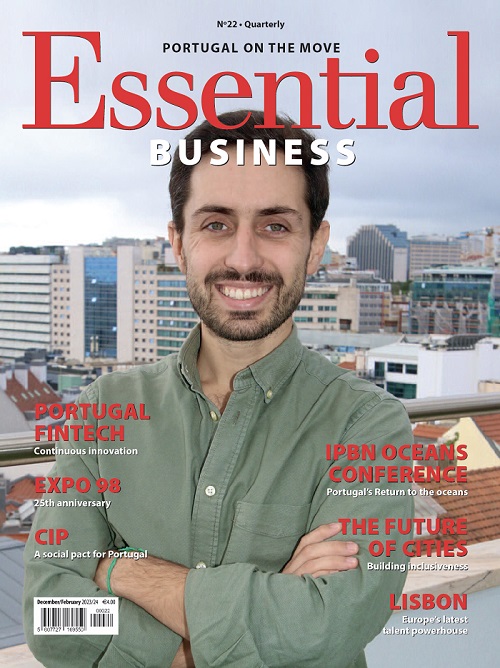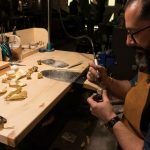The face behind Lisbon’s successful fairs
Few people know the development of trade fairs in Portugal like Fátima Vila Maior.
After all, she’s been involved in organising fairs one way or another for nearly 40 years.
Fátima Vila Maior is the director of fairs at Feira Internacional de Lisboa (FIL).
As director for the Fundação AIP (the Portuguese Industrial Association Foundation), she is in charge of the Lisbon tourism fair BTL (Bolsa de Turismo de Lisboa), the design fair LxDesign and the international handicrafts trade fair FIA (Feira Internacional de Artesanato). Involved with fairs since the 1980s, she has become a master at organising them.
Organising fairs has been and still is a large part of her life and that makes her somewhat of an expert in her field. But things have changed since the 1980s when she started out at the old Congress Centre near Belém.
The fairs have grown in size and number, become more sophisticated, innovative and technology-driven with increasing links between some of them.
One key point Fátima Vila Maior stresses is that although the fairs are separate and distinct, many are interlinked by overlapping services, companies and applications. This is hardly surprising since tourism, in all its varied forms, makes up around 7% of Portugal’s GDP and probably even higher.
The Lisbon tourism fair BTL overlaps with the Portugal property fair SIL (Salão de Imobiliário de Portugal) in many areas. Food, beverages, hotels, travel agencies, airlines, all interact and impact the tourism, hotel, catering and restaurant industries, which, in turn, link with property and other sectors.
“Tourism as an industry is transversal, part culture, part gastronomy, so nearly everything is related either directly or indirectly,” she explains.
Multicultural craft
Fátima Vila Maior emphasises that artisan crafts are a critical product for Portugal and very important for tourism. “Statistically, 80% of tourist flow is attracted by culture (the sights, cuisine, monuments and museums, and popular festivities),” she says.
Now in its 13th edition, the international handicrafts fair FIA in Lisbon has never been so well-attended or dynamic. It is the second largest fair of its type in Europe and attracts exhibitors from as far as South America, Africa and Asia, with countries including Cuba, Senegal, Morocco and India.
Morocco was one of the key markets at FIA, which ran from June 23 to July 1, with 500sqm of exhibition space.
“Morocco is important precisely because of its habits, culture and handicrafts, and I believe that after seeing the stands, many Portuguese will be curious to visit that country,” she says.
“Morocco was our guest destination at the 30th edition of BTL (February 28 – March 4), where thousands of visitors discovered more about this destination and the diversity it is famous for: sun, beach, desert and exoticism — all highlighted over a 108sqm exhibition area.”
Here BTL capitalised on the airline destinations offered by TAP Portugal which flies to Morocco’s Marrakesh, Casablanca, Tangiers and Fez.
“The event is important for tourism but also for companies that invest in hotels and tourism,” she points out, adding that the Pestana Group, for example, is developing a hotel in Marrakesh, the Pestana CR7 (bearing Portuguese football sensation Cristiano Ronaldo’s brand), which will open in 2019 to complement the Pestana Casablanca Suites and Residences that opened in 2013.
But it’s not just about providing a window for Portuguese consumers, suppliers, service providers and businesses onto these markets. It’s equally about showcasing Portugal and its culture, handicrafts and gastronomy.
This year’s theme at handicrafts fair FIA was the ‘arraial’ or open-air street parties and festivals, with particular emphasis on Lisbon’s Popular Saints celebrations which feature the traditional neighbourhood ‘sardinhadas’ – charcoal-grilled sardines washed down with plenty of beer and fruit-filled sangria.
BTL attracting new markets
Lisbon’s annual tourism fair BTL has a very clear strategy which reflects the industry’s desire to capture new markets beyond Spain (the most important) and the traditional ‘sun, sea and sand’ concept that used to be marketed for the United Kingdom, France, Germany, Ireland and Scandinavian countries.
“Spain is still Portugal’s biggest single market, but it’s not the main focus for BTL – there is the United States, Brazil and other new tourist markets like China, South Korea and India,” says the fairs director.
One factor that is contributing to putting Portugal on the map as a holiday destination is BTL’s Hosted Buyers Programme. The programme is organised by BTL in partnership with Turismo de Portugal and the airline TAP Portugal and brings international buyers to Portugal who are interested in the country as a tourist destination.
“The overseas buyers are invited from key new strategic markets, particularly ones where new routes have been opened up by airline TAP Portugal,” says Fátima Vila Maior.
In 2018 there were 400 hosted buyers from 45 markets of origin at BTL which took part in 5000 meetings.
“In terms of strategic markets, Brazil has been the ex-libris for BTL for many years, ever since TAP has had its Brazilian hub in Lisbon and flies to all major cities in Brazil.”
In fact TAP is the European airline operating the most flights to the greatest number of destinations in Brazil (Rio de Janeiro, São Paulo, Recife, Salvador da Bahia, Belém, Belo Horizonte, Brasilia, Fortaleza and others) and BTL has capitalised on the links with these destinations by sharing information from overseas buyers with Portuguese companies, including tour and hotel operators and travel agencies.
“We want to show international buyers from Brazil what Portugal has to offer and boost overseas business here and in other major markets,” explains Fátima Vila Maior.
“TAP has created new links with the Middle East, China, South Korea and India. Our task is to bring these new markets to BTL.”
The US is another country the national tourism board (Turismo de Portugal) and BTL are focusing on now, not so much in terms of promoting beaches and resorts which, in common with Brazil, are abundant in the US, but rather the heritage of 1000 years of history, the Portuguese culture, the excellent hotels, the Douro Wine Region and other World Heritage sites which are attractive assets for Americans.
Record demand for property fair
Now in its 21st edition, SIL is probably, along with BTL, the most important fair in terms of investment, having drummed up over €120 million of investment in 2017.
The biggest fair for the property sector, it is organised by Fundação AIP with the support of Lisbon City Council.
Running from October 3-7, this year’s event is already 70% subscribed, with an expected attendance of 350 companies and entities from the property sector, 150 national and international investors and 65,000 visitors. Because of record demand (+25% in one year), the exhibition area has been increased by 100%.
“I was director of SIL for three editions 15 years ago and remember when the initiative started shortly before Lisbon hosted the international world fair Expo’98,” recalls Fátima Vila Maior at a time when the notion of urban rehabilitation and the second-homes market “really didn’t exist”.
“Now, it’s staggering just how much this fair has grown. We’ve doubled our exhibition space in just one year, we have two pavilions and we’re seeing growth of 100%,” she adds.
Drumming up international investment
In recent years, SIL has been involved in various roadshows and missions overseas with the aim of attracting international investors. “This year we’re expecting the largest number of international buyers, since foreign investment represented 20% of all housing transactions in 2017,” she says.
France is currently the country which is investing the most in the Portuguese residential market, followed by Brazil, the UK, China and Angola. To that effect, specific campaigns are being organised for SIL 2018, including SIL Investments Pro, a side-event catering solely for professionals on October 3 at the PT Meeting Centre, adjacent to FIL at Lisbon’s Parque das Nações.
Two major themes will be under discussion: ‘Investment in Large Property Projects’ and ‘Investment in Residential Tourism’. This will include a networking area for international investors (Spain, the UK, France, Brazil and the USA), including developers and consultants.
Another new development is SIL Cidades (SIL Cities), an area set aside for cities to promote and market their property assets to attract investment. The invited town this year will be Seixal, a peripheral area on the south bank of the River Tagus with a strong growth potential which will present projects in development.
Looking back 20 years
Looking back over a career of nearly 40 years’ involvement in international fairs, Fátima Vila Maior reflects on just how much Lisbon and Portugal has changed, particularly since 1998, the year of Expo’98.
“When I look at photos of Lisbon in the early 80s, it’s hard to believe it’s the same city. Today, it’s a thriving, vibrant and pulsating European capital that is trendy not only as a city-break and conference destination.
“Back then, Lisbon was a sleepy backwater of quaint, faded charm, run-down buildings and deserted streets after 8pm. Now, it’s bustling, full of lovely shops and modern shopping centres, world-class hotel chains, superb resorts offering top-quality properties, trendy nightclubs, themed bars and chef signature restaurants. It’s incredible how it has changed since I started back in 1983,” she recalls.
Fátima Vila Maior highlights the food industry and retail sector to illustrate this change. “Back in 1983, most quality foods were imported and our modest supermarkets were nothing to compare with the ones overseas.
“Now, we’re up there with the best, we’re selling excellent top-quality produce from our different regions, much of it for export, and foreigners are bowled over by our offer. We are a lot more innovative than we were then. After years of discovering the world, we’re rediscovering our own culinary, cultural, natural and patrimonial heritage. We’re believing in ourselves and that what we have is good and worth shouting about. Now the nation of discoverers is being discovered.”










